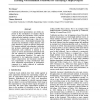Free Online Productivity Tools
i2Speak
i2Symbol
i2OCR
iTex2Img
iWeb2Print
iWeb2Shot
i2Type
iPdf2Split
iPdf2Merge
i2Bopomofo
i2Arabic
i2Style
i2Image
i2PDF
iLatex2Rtf
Sci2ools
110
click to vote
ICML
2009
IEEE
2009
IEEE
Learning non-redundant codebooks for classifying complex objects
Codebook-based representations are widely employed in the classification of complex objects such as images and documents. Most previous codebook-based methods construct a single codebook via clustering that maps a bag of lowlevel features into a fixed-length histogram that describes the distribution of these features. This paper describes a simple yet effective framework for learning multiple non-redundant codebooks that produces surprisingly good results. In this framework, each codebook is learned in sequence to extract discriminative information that was not captured by preceding codebooks and their corresponding classifiers. We apply this framework to two application domains: visual object categorization and document classification. Experiments on large classification tasks show substantial improvements in performance compared to a single codebook or codebooks learned in a bagging style.
ICML 2009 | Large Classification Tasks | Machine Learning | Single Codebook | Visual Object Categorization |
Related Content
| Added | 17 Nov 2009 |
| Updated | 17 Nov 2009 |
| Type | Conference |
| Year | 2009 |
| Where | ICML |
| Authors | Wei Zhang, Akshat Surve, Xiaoli Fern, Thomas G. Dietterich |
Comments (0)

